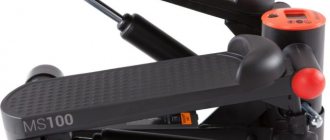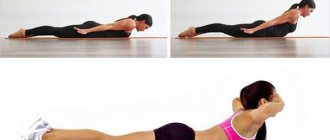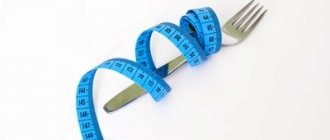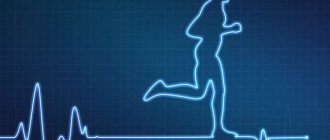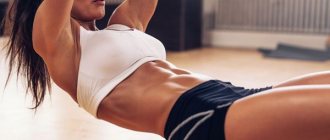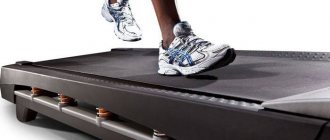Let's talk about the stepper - a popular exercise machine that you have probably seen in training rooms. We will take a detailed look at what a stepper is - what muscles work during exercise, what benefits this device brings to health, what types of stepping machines exist, and how to properly exercise on a stepper.
Modern people walk much less than even in the last century. Having your own car, sedentary work in the office or at home, preferring passive over active rest - all these factors do not contribute to slim legs and buttocks. It is not surprising that there are more and more people with excess weight, and girls have to fight for a slim figure with all possible means.
The load on the musculoskeletal system in modern people is minimal: this is reflected in both the figure and well-being. Osteochondrosis, arthrosis of the knees and hips have become commonplace in the prime of life. Not everyone has the time to regularly visit the gym and beauty salons. In this situation, the most expedient and effective way to solve the problem would be to purchase a home exercise machine.
Stepper simulator - general information
First, let's figure out what a stepper is. This device is a cardio machine that simulates climbing stairs. The name comes from the English “step”, that is, “step”. Like other cardio equipment, this equipment provides a person with the necessary volume of movements that are natural to him. Stepper exercises are aimed primarily at strengthening the muscles of the legs, thighs and buttocks.
Most people who purchase this exercise machine practice exercises on a stepper for weight loss and figure correction. In fact, the benefits of the stepper are more multifaceted than eliminating extra pounds:
- the exercise machine strengthens the heart and blood vessels,
- stimulates and develops the respiratory system,
- makes the back and abdominal muscles work.
The main advantage of the stepper is its ease of operation. In addition, the device does not take up much space and is relatively inexpensive. For home use, mini-steppers are usually chosen: compact and functional devices from the world's leading manufacturers of sports equipment. Today, you can easily choose and buy a stepper for your home in an online store or a regular sporting goods store.
Types of steppers
There are several types of steppers. Based on size, these simulators are classified into two types:
- Regular steppers;
- Mini steppers.
The first option is a rather large design: such a simulator is equipped with handrails that help maintain balance, or levers that provide additional stress on the muscles of the arms and back.
Mini steppers are a simple platform with pedals. Some modifications are also equipped with additional devices. A stepper with expanders allows you to load your arms and back while walking. This is the most effective machine for cardio training at home.
Based on the type of movement, devices are divided into:
- Classic;
- Balancing;
- Rotary.
The classic simulator simulates climbing stairs as accurately as possible (in anatomical and physiological terms).
The balancing apparatus, as the name suggests, helps further develop coordination and strengthen the abdominal muscles. When moving, such a platform shifts the center of gravity of the body in different directions. At first, the movements may seem difficult, but after gaining the dexterity, you can supplement walking with various movements of the arms and legs, giving additional load. This model is often called the “rock and roll stepper”: the exercises really resemble the familiar energetic dance.
The rotary stepper simultaneously loads the back, since when walking you need to turn your body. Exercises on such equipment are characterized by increased intensity: after literally 10 minutes of exercise, a person receives a load on all the muscles of the body and especially on the “breeches zone”, a problem for many women.
According to the nature of their performance, steppers are divided into:
- Professional – used in the halls and are characterized by increased resistance to wear (these models can work almost around the clock);
- Autonomous - run on batteries or built-in generators;
- Folding - do not take up much space, but are less durable and are not designed for intensive training.
Steppers are also divided into mechanical and electromagnetic. The first type operates hydraulically. The trainee presses on the pedal, the cylinder compresses, and when the weight is transferred to another pedal, it unclenches. These models do not make noise during operation and do not require an external power source.
Electromagnetic devices operate due to the magnetic resistance of the pedals. The load can be adjusted via the control console. Modern models are equipped with many functions, have built-in training programs or allow you to create an individual training plan. At the same time, various vital signs are read using sensors placed on the body:
- Pulse rate;
- Number of steps taken;
- Movement speed;
- Number of calories burned.
Such exercise machines are rarely used at home and are more suitable for gyms and fitness centers.
Types of simulators
When choosing a stepper, you need to focus on its size. A small copy costs less than a standard one. It is perfect for budget-conscious people and those who have little space in their apartment. They are divided into:
Standard.
Full-fledged exercise machines with handrails or levers that help evenly distribute the load on the back muscles. Not suitable for small apartments. Often used in gyms;
Mini exercise machines.
Simplified steppers, which are devices with pedals. Essentially, this device is half of a regular stepper, which includes only the body and pedals. Sometimes an expander is sold complete with them, which adds stress to the back and arms. You can study on it while sitting on the couch in front of the TV. The ministepper will help save both space and money;
Classic.
Such simulators completely simulate climbing stairs. They come with dependent and independent pedal travel. The leg exerciser does not load the joints, but, on the contrary, removes excessive load from them;
Balancing.
Such devices have a more complex structure, because during exercise the platform moves, shifting the center of gravity. This forces more and more muscles to work (even the abs). It is much more difficult to practice on it than on the classic one, but the result is worth the effort. This device burns more calories than the classic one;
Rotary.
Such exercise machines are great for loading your back during exercise. Great for intense workout enthusiasts. The rotary stepper pumps the rhomboid, quadratus and trapezius muscles;
Hydraulic.
They create strong tension during exercise due to a special built-in screw, which also regulates the load.
Steppers also differ in their design. They are divided into folding, autonomous and professional. The latter type is usually used in gyms, it is large in size and durable. The second type of device can run on batteries, and therefore is great for use at home. Folding steppers are also small in size. Their only drawback is their low strength, so you won’t be able to train intensively on them.
Practical advice: If you do not have space in your apartment for a stepper, then you will have to purchase a not very reliable, but compact folding exercise machine. Another advantage of such a stepper is that it costs less than a standard one.
They also differ in their structure. There is a mechanical type, which is great for use at home, as well as an electromagnetic type, which is most often purchased for fitness centers and gyms. Mechanical steppers are designed quite simply, because their action is based on hydraulics. When a person presses on the pedal with one foot, the cylinder compresses, and when pressure is applied to the other, it expands. Electromagnetic devices, accordingly, are more complex, since they include console control, important functions and training programs.
Video
Benefits of a stepper
The therapeutic and aesthetic effects of the stepper are numerous and varied:
- Weight stabilization by burning fat deposits;
- Strengthening the muscles of the legs and buttocks;
- Back and abs training;
- Figure correction;
- Training of the heart muscle and blood vessels;
- Stimulation of the respiratory system;
- Development of coordination;
- Stimulation of metabolic processes;
- Strengthening the immune system.
Regular training on a stepper is useful for everyone who cares about the slimness of their body and the full physiological load of the musculoskeletal system. As a therapeutic agent, the device is recommended for people at the rehabilitation stage after the main course of treatment for injuries and degenerative diseases of the limbs and spine.
How to train on a simulator with maximum efficiency
The main condition for successful training is consistency of practice. It is advisable to train three times a week. Walking on a stepper should not be too intense - especially in the first months of training: avoid overload and muscle strain.
Be sure to monitor your heart rate (first, determine your heart rate and calculate your exercise rate). The rule of thumb for determining the acceptable threshold is 200 beats minus age. If the number of heart beats begins to exceed the permissible values, rest and restore your breathing. The frequency of inhalation and exhalation is an indicative criterion for the intensity of exercise. If you feel difficulty breathing, it means you are overloading your body: increase the load consistently. It would not be superfluous to consult a therapist before purchasing a simulator or starting classes.
Another indispensable condition for achieving maximum benefits from training is methodicality. Perform the movements correctly, at an average rhythm, without excessive tension.
There are several movement options that are suitable for both beginners and people with experience:
- Standard step: keep your body straight and walk as if climbing stairs. You can increase or decrease the pace by changing the pressure of your foot on the pedals.
- Half-foot step ("half-foot"): straight body, quick and small steps with emphasis on the forefoot.
- Heavy step: the body leans slightly forward, the foot is fully supported, the pressure is slow, with noticeable effort.
The first workouts should be short: no more than 10 minutes. three times a week. Gradually, the duration of classes can be increased to 30 minutes. in a day.
General rules for practicing on a stepper:
- Be sure to warm up (5-10 minutes);
- Exercise in comfortable shoes that provide reliable grip on the surface of the platform:
- Train in clothes made from natural fabric;
- During the first lessons, you should not move without support - hold on to the handrails and watch your balance;
- Beginners should place their foot fully on the pedal to avoid overloading the ankle joint;
- Choose the optimal range of movements: do not bend your legs too much and straighten them at the knee joint to the end;
- To lose weight, choose a regimen with a high cadence and low resistance.
Check the functionality of the simulator before use. Make sure that all components of the device are present and securely fastened. If you find it boring and uncomfortable to exercise in silence, you should choose specific music for training. Ideally, the rhythm of the musical accompaniment will coincide with the rhythm of your steps.
Some features of exercises on a stepper and the number of calories burned
Exercises on a stepper, as we have already said, help burn extra pounds . Reviews and contraindications for this device allow you to analyze the pros and cons and make your choice.
During intense training, the stepper burns up to 500 Kcal per hour!
What does a stepper pump and how many calories does it burn? With it you can perform aerobic exercise , i.e. burn fat deposits, while strengthening the muscles of the heart and blood vessels, as well as training the muscles of the body. At the same time, if you exercise on this simulator with medium intensity, you can burn up to 250 calories in half an hour of exercise .
By the way, the intensity of stepper training needs to be increased gradually. You don't want to push the pace too hard for the first few months, otherwise you'll overexert your muscles. As experts advise, you need to exercise on a stepper three times a week, which, in principle, is a standard training regimen for the gym. There should be at least one day of rest between classes.
As for the expected results from working out on a stepper, it all depends on the regularity of training, as well as the individual characteristics of the body. It is also important which muscles work on the stepper during your exercises - if you choose an easier option for moving and placing your foot, protecting any of the muscles from stress, do not expect good results. The lesson should be as effective as possible.
As a rule, during the first week of classes the body will still adapt to new loads, so you should not expect noticeable changes. In the future, as practice shows, the results will be more than successful - a person will lose about three kilograms per week.
Walking, including walking up stairs, is one of the oldest forms of physical activity and one of the most accessible. People of almost all ages can do it for their health; it is recommended even for those who, for example, cannot run. Exercises on a stepper can successfully replace it.
And if such a simulator “settles” in your apartment, training is not canceled either because of the weather or because of an inconvenient schedule in the fitness room. We’ll tell you what benefits you’ll get and who should avoid step loads right now.
Who should not use the stepper (contraindications)
We have already talked about the need for medical consultation (even if you are 20 years old and have no health problems). It’s better to play it safe than to get spinal damage (in the presence of hidden pathologies) or provoke the development of internal diseases.
It is not recommended to conduct training in the following cases:
- For untreated injuries of the limbs and spine (sprains, dislocations, injuries);
- If there are serious diseases of the heart, kidneys, liver;
- During pregnancy (2-3 trimester);
- If you have diabetes mellitus in the stage of decompensation;
- With arterial hypertension of 3 degrees.
You should not exercise if you have a cold, inflammatory or infectious disease with fever. For older people, consultation with a doctor is mandatory.
How to choose a reliable stepper for your home
To choose a stepper for your home, it is better, of course, to ask a specialist (gym trainer) for advice. A salesperson in a store may offer you not the most comfortable, but the most expensive model. Much depends on your own financial capabilities and (most importantly) the free space in your living space.
If you have purely practical goals (lose weight, remove fat from the thighs and buttocks), then the simplest and most inexpensive modification will do. If you are going to track your training progress and are not limited in funds, purchase the most expensive model with the ability to customize and reconfigure and functions for monitoring vital signs. Such devices will clearly show how many calories are consumed, how many steps are taken, and what is the heart rate.
If you want to get by with the minimum, buy a regular (or rotary) hydraulic simulator. If you don’t have enough space in your apartment, take a mini-stepper or a “rock and roll” model. Such steppers are convenient and functional, but do not allow you to adjust the load. The price range for this equipment is 1,800 - 20,000 rubles.
The effectiveness of exercises on a stepper for weight loss
Losing weight on a stepper: burning excess calories, accelerating metabolism and, as a result, a fit and clear body line.
Peculiarity! To enhance the effect, you need to limit yourself to carbohydrates, but increase the proportion of protein foods. With such a balanced diet, the available weight loss is about 1 kg per week.
What should you consider when losing extra pounds?
How to start? From 10-15 minute sessions with low intensity, but not less than the lower limit of the heart rate. Don’t forget about warming up the muscles at the beginning and cool-down-stretching at the end of the cardio session (5-10 minutes each, depending on the time of training). Gradually, as the muscles adapt, increase the training time to an hour over the course of a month. But even 15 minutes every day will show themselves in a month. Duration. For the purpose of losing weight, the optimal time is 40-60 minutes at low intensity (pulse is about 100-110 beats per minute for beginners and 120-130 for intermediate training). The “25-minute rule” works here - during this period of training, blood sugar and carbohydrate glycogen from tissue cells are consumed, and only after these minutes the fat burning process starts. Periodicity. 2-3 times a week is ideal for both beginners and experienced fitness people. The difference is in the intensity of the load. In the morning or evening? For those who want to lose weight, morning is preferable. A sharp transition from a lazy state to an active one will help the body burn fat more intensely to compensate for the energy expended.
Attention! In 30 minutes, at the specified intensity, 250 kilocalories are “burned” on the stepper. This indicator is similar to the calorie expenditure when jogging.


